The Patel Communities have been migrating to East Africa since 1890’s. They established themselves as a very hard working, honest, religious and skilled community. Their contributions to East Africa is phenomenal. We try to present some of the aspects of their lives, which were not beds of roses but which bore exceptional fruit and made them the most admired and rich people of this African sub continent.
Some of the material has been taken from a book by Cynthia Salvadori, "We came in Dhows" , which tells the story of the Indians whose history and culture had remained virtually unrecorded despite their conspicuous economic importance.( Congratulations & thanks are due to her for her extensive research on the Indian Community who developed East Africa)
The Gateway to East Africa – tempting the Indians to join the new Railway Line, which will eventally open the doors to one of the best countries in the world. The means of travelling in those days was this dhow, which brought them from India to East Africa.
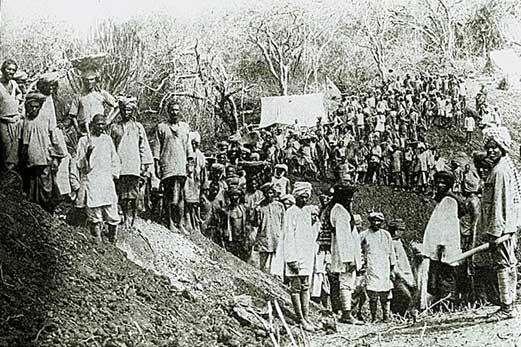
Workers on the Uganda Railways

Workers on the Uganda railway line
 Train with railway employees & administrators. (top & bottom)
Train with railway employees & administrators. (top & bottom)
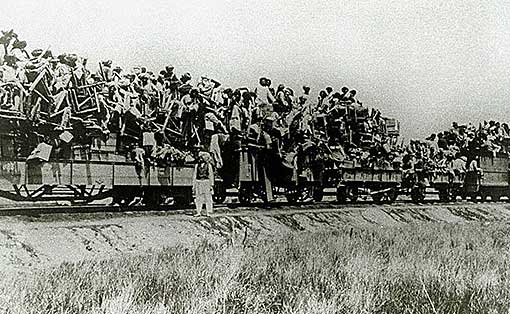
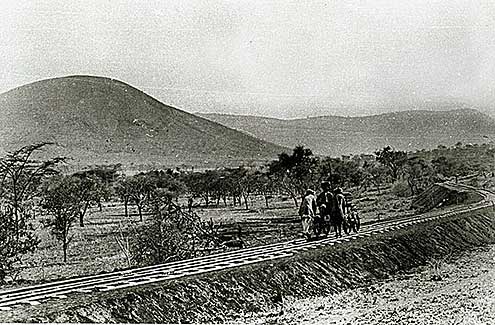
Railway track near Sultan Hamud
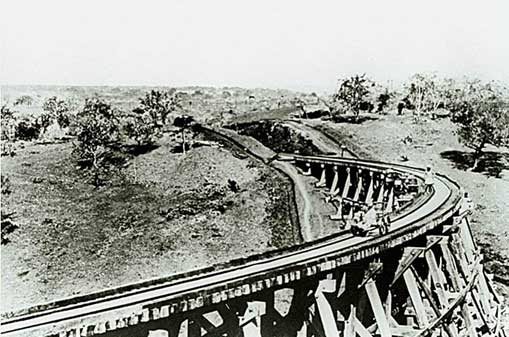
Railway bridge near Mazeras
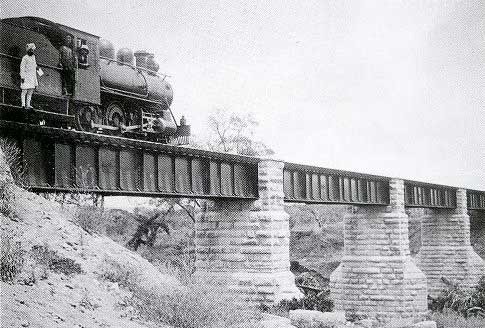
Crossing the Tsavo Bridge

Train near Mombasa about 1899 CE
59 Class Garratt
EAST AFRICAN RAILWAYS
The 59 Class Beyer-Garratts were the largest
and most powerful locomotives ever built to operate on a
metre gauge railway. Designed to haul 1200 ton freight trains
over the steep east African mountains, they proved to be
as tough as the terrain they conquered.
The 59 Class Beyer-Garratt was the culmination of half a century of experience with articulated locomotives. They were designed and built to answer a desperate need: to haul heavy loads on the tight curves and steep gradients on some of the most difficult terrains in the world – the railways of east Africa.
Railways in east, west and southern Africa are mainly of metre and 3ft 6in gauge, though there are scattered lines of narrower gauge. Many of them were built at the end of the last century, during the grab for colonies, to exploit the natural resources of the continent by carrying them overland to the sea for export.
Building a railway
Kenya and Uganda, British protectorates since 1894/5, were dependent for their external trade on the port of Mombasa. To link the port with the hinterland a metre gauge railway was started in 1896, pushing north-west to reach the site of Nairobi in 1899. Nairobi was then a swampy plain devoid of habitation but destined to become Kenya’s capital. The line was extended through mountainous country, to reach Lake Victoria -source of the White Nile – at Kisumu in 1901.
Various branches were built to open up the country and later to link with the system in Tanganyika (now Tanzania), previously a German colony. An extension to Kampala, the capital of Uganda, was not completed until 1931.
Nairobi is reached after a climb of 5750ft (1750m). Beyond, the line climbs a further 7700ft (2347m) to Uplands before descending 6000ft (1830m) to the floor of the Great Rift Valley. A final climb takes the line to its summit at Timbora, 9136ft (2784km) above sea level.
 In Dec 1977 No.5918 Mount Gelai hauls the A38 goods eastwards from Samburu over steep gradient towards Mackinnon Road. The 59 class was well suited to hauling heavy loads. They had double the tractive effort of any locomotive employed on passenger service in the UK, where they were built in 1955.
In Dec 1977 No.5918 Mount Gelai hauls the A38 goods eastwards from Samburu over steep gradient towards Mackinnon Road. The 59 class was well suited to hauling heavy loads. They had double the tractive effort of any locomotive employed on passenger service in the UK, where they were built in 1955.
The terrain through which these lines were built called for heavy, sustained gradients and many curves. Consequently the railways’ capacities were generally very limited. Much of the line was originally laid with 501b/yd rail, but by the late 1920s the Mombasa – Nairobi section had been relaid with new, heavier 801b/yd rail and this was subsequently extended to Kampala. This sort of railway and the Beyer-Garratt articulated locomotive became synonymous.

During the 329 miles journey between Mombasa & Nairobi there would usually be two stops for oil and six to eight stops for water. In the early 1960’s No. 5901 ‘Mount Kenya’ replenishes its water supply at Tsavo station.
Enter the Garratt
The Garratt’s use of two engine units carrying fuel and water (water in the front, fuel and water in the rear) gave good flexibility on curves, while the boiler cradle was carried on pivots between them. This allowed a very large boiler to be mounted, its firebox completely unobstructed by wheels below it. The spread of weight over many axles – 14 or 16 in the case of the east African machines – kept individual axleloads down while providing ample adhesion and therefore power.
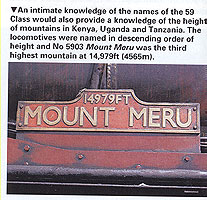
The first Beyer-Garratt, a small locomotive produced for work in Tasmania, Australasia, was built in 1909 and is now in the National Railway Museum, York. The articulated locomotive concept grew steadily into the South African giant built in 1930 which is now preserved in the Museum of Science and Industry, Manchester.
In 1926 the Kenya & Uganda Railway placed its first Garratt order, for four EC Class 4-8-2+2-8-4 wood-burning engines, which were used west of Nairobi and permitted to haul 457 tons on the 1 in 50 gradient. After a satisfactory two year trial the railway decided that its future lay with Garratts for main line work. Successive orders culminated in the majestic EC class 4-8-4+4-8-4 (later Class 57). These locomotives instituted through running between Nairobi and Kampala.
Different types of Garratt locomotives handled the given loads successfully until the early 1950s when, thanks to continuous traffic growth, the Mombasa – Nairobi section became a bottleneck with exports and imports being seriously delayed. By now the track here had been relaid with 951b/yd rail and was already supporting the 17’/2 ton axleload of the EA class 2-8-2s. Careful study of locomotive forces acting on the track showed that axleload up to 21 tons could be borne, provided that the weight tapered off at each end of the locomotive.
Production of the 59s
In 1954 the UK locomotive builder, Beyer-Peacock, was asked to produce a new and much bigger 4-8-2+2-8-4 Garratt, capable of hauling 1200 ton trains on the 1 in 66 gradients and with the enormous tractive effort of 83,3501b. The 34 engines of the 59 Class were delivered in 1955 in an attractive livery of dark red lined out in yellow. Most were given names of mountains in east Africa.
Everything possible was built into the engines to give sustained power and high mileage between overhauls. They had bar frames machined from 4V2in thick slabs and roller bearings on all axles and big ends. The boiler was enormous, with a barrel diameter of 7ft 6in – 6in larger than the LNER’s solitary 2-8-0+0-8-2 Garratt – and was oil fired. If they had burned coal (and provision was made to fit a mechanical stoker if a change to coal was ever necessary), the grate would have had an area of 72sq ft – half as much again as a Bulleid Merchant Navy Pacific. The front and rear tanks were of Beyer-Peacock’s later streamlined form and a power reverser was provided. Air braking for engine and train was standard.
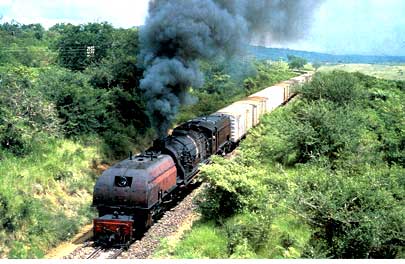
The main work of the 59 class was hauling trains of imports & exports between the port of Mombasa and the towns of Nairobi ans Kampala. While the eastbound trains contained exports of tea, coffee and agricultural produce, the westbound trains included imports of farm machinery, fuel and consumer imports. On 21 December 1977, No. 5912 ‘Mount Oldeani’ toils uphill with a westbound train of imports to Nairobi.
An interesting feature built into the 59s, like all engines for east Africa since pre-war days, was ease of conversion to 3ft 6in gauge if there was a link with the systems in Rhodesia (now Zambiaand Zimbabwe) and South Africa. All wheel rims were just over one inch wider than normal, so that new tyres could be shrunk on to suit the wider gauge.
On test the specified 1200 ton load was handled comfortably and even exceeded. Such was the impact of these remarkable locomotives and their heavier trains (1400 tons permitted between the coast and Nairobi) that within 12 months the main line operation was back to normal and congestion at Mombasa was at an end.
Working days
During normal service the 59s were manned by two regular crews on a caboose basis, one working and one resting in a van with sleeping accommodation, changing over at eight hour intervals. The engines were kept very clean and the cabs were polished and immaculate.
The performance of the locomotives, if not their appearance, was further enhanced between 1959 and 1967 by the fitting of Giesl ejectors in place of the original single chimneys. This led to separate timings for single chimney and Giesl Garratts, enabling, for instance, several hours to be saved in running between Kampala and the summit at Timboroa.
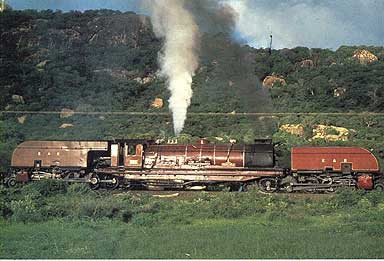
No. 5918 ‘Mount Gelai’ shows off its lines in the evening sun on 19/12/1977. An advantage of the Garrats was the absence of wheels under the centre section.
But, as elsewhere, the diesel locomotive was in the ascendant, even though two were required to do the work of one Garratt. Withdrawal started in 1973 and the fires were doused on the last 59 Class in 1980. Two were saved from the torch and restored to working order.
It was also the end for the locomotive building firm of Beyer-Peacock. In the late 1950s the demand for steam engines collapsed worldwide and the firm’s entry into diesel and electric traction came too late. The works closed in 1966. (Article courtesy ‘The World of Trains’ )
Following Excerpt taken from ‘Steam Safari’ written by Colin Garratt....
Many 59s have Sikh drivers, the most famous example being 5918, Mount Gelai– a brass plate from this engine’s cab is sketched below. The overall condition of Mount Gelaiis possibly unrivalled anywhere in the world today. Her cab interior is more akin to a Sikh Temple than a locomotive footplate for its boiler face abounds in polished brasswork, embellished with mirrors, clocks, silver buckets and a linoleum floor. The crews are known throughout East Africa as the ‘Magnificent Foursome’ and so well do they care for their steed, that a failure is almost unknown and no breakdown in traffic has ever been recorded against this engine since they took over ten years ago. She has the highest mileage record between shoppings and on several occasions 5918 has been taken to Nairobi Works for overhaul as a matter of policy, rather than for any recognisable necessity!
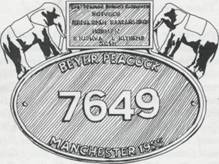
Twenty ‘Mountains’ are allocated to Nairobi, whilst the remaining fourteen belong to Mombasa. The Mombasa engines can be easily picked out by their black backed number and name plates, compared with Nairobi’s red ones. How these engines are revered by crews and engineers alike; little inducement being needed to evoke an enthusiastic discussion. The following fragment from my conversation with a locomotive fitter at Mombasa will convey the spirit – such were his phrases. . . . ‘Yes, 5931 is the cleanest, but then she’s only been out of shops a month — and with the official maroon livery too. 5913 is chocolate brown – she belongs to Nairobi. They say that 5912 is the best – that’s the one with wing plates on the smokebox, I’ve heard tales that she will go up Miritini bank with a full load at fifteen per cent cut off- but I doubt it. 5906 has a cracked frame and one of her drivers is acting day foreman here whilst his engine is in Nairobi shops. The one that always gets the limelight is 5918, but you know about her. I agree, the names are impressive, personally I like 01 ‘Donya Sabuk –she’s one of ours, we have her in the sick bay at present, you’ve possibly seen her. Did you hear about 5917 hitting a herd of elephants last week?’ I hope such lyrical phrases as these convey something of the spirit; to me they almost constitute a style of free form poetry. Here is the 59 Class:
- 5901Mount Kenya 5918 Mount Gelai
- 5902Ruwenzori Mountains 5919 Mount Lengai
- 5903Mount Mem 5920 Mount Mbeya
- 5904Mount Elgon 5921 Mount Nyiru
- 5905Mount Muhavma 5922 Mount Blac.kett
- 5906Mount Sattima 5923 Mount Longonot
- 5907Mount Kinangop 5924 Mount Eburu
- 5908Mount Loolmalasin 5925 Mount Monduli
- 5909Mount Mgahinga 5926 Mount Kimhandu
- 5910Mount Hanang 5927 Mount Tinderet
- 5911Mount Sekerri 5928 Mount Kilimanjaro
- 5912Mount Oldeani 5929 Mount Longido
- 5913Mount Debasien 5930 Mount Shengena
- 5914Mount Londiani 5931 Uluguru Mountains
- 5915Mount Mtorwi 5932 01 ‘Donya Sabuk
- 5916Mount Rungwe 5933 Mount Suswa 5917Mount Kitumbeine 5934 Menengai Crater
………………………………..
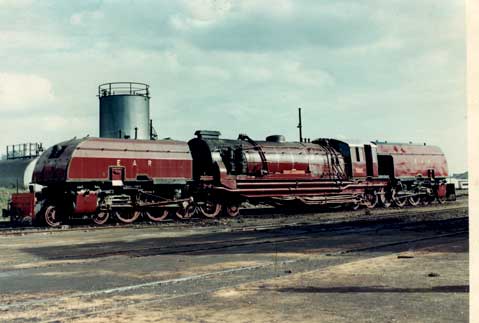
Mount Kilimanjaro
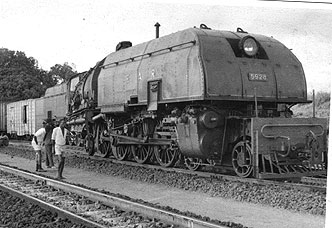
Mt. Kilimanjaro
The inside of the Mt. Kilimanjaro
At a station

In this instance the Kilimanjaro was just saved from being derailed as the signalman had changed tracks without realising that the train was still on the other track.
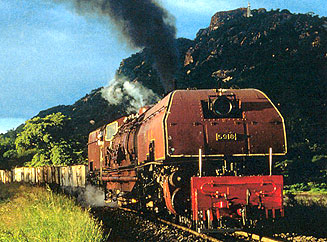
Driver Kirpal Singh with his train near Kibwezi

Kirpal’s train (photo courtesy Kevin Patience)
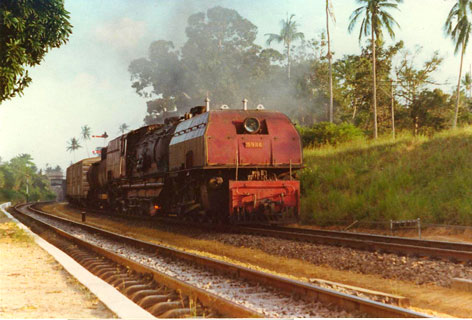
Kirpal’s train at Changamwe (photo courtesy Kevin Patience)
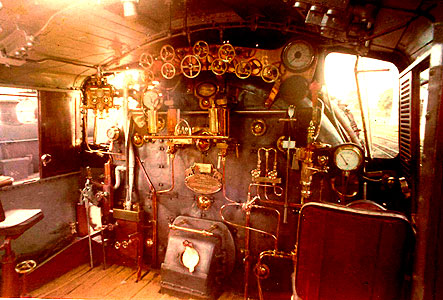
Inside the above train (photo courtesy Kevin Patience)
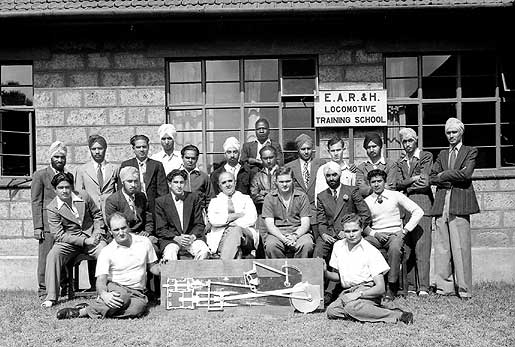
Students with teachers at a Railways training School (any recognitions?)

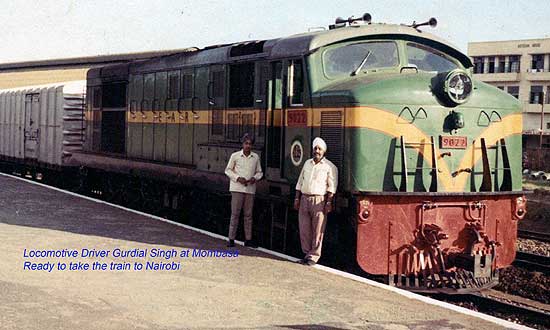
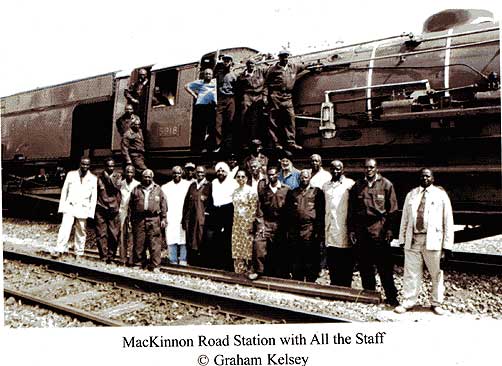
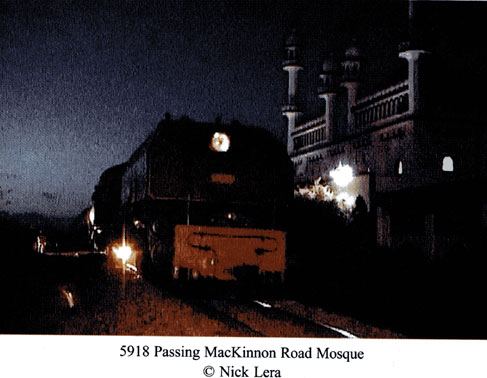
Charan & Kirpal at the end of their historic journey pose with their partner 5918. Photo courtesy Nick Lera (Steam Safari)
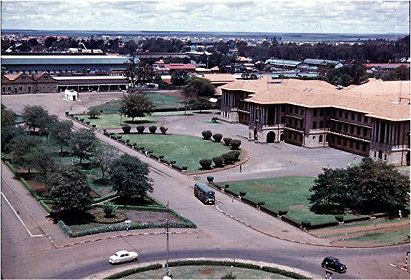
Railway head quarters Nairobi
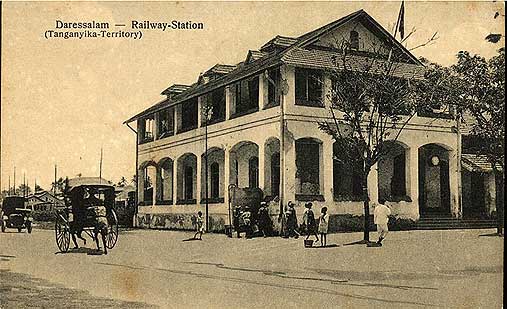
Dar-es-Salaam Railway Station 1930’s
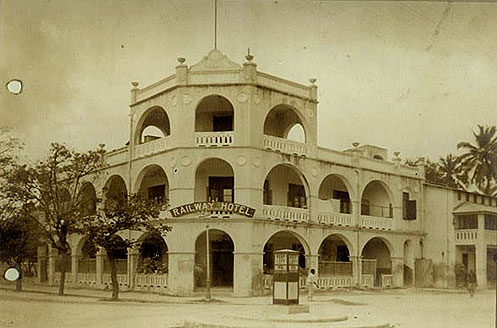
Railway Hotel Dar-es Salaam

Nairobi Railway Station
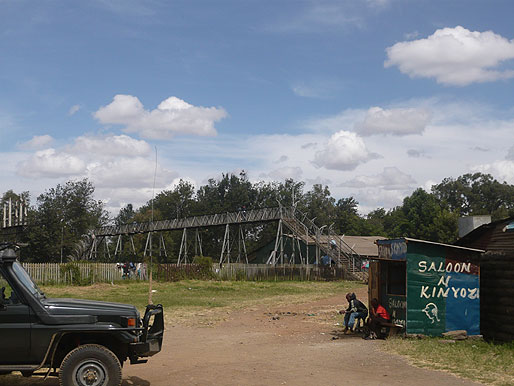
The OLD railway walking bridge from the Nairobi Railway station to the other side near Gurdwara Railway landhies. (see the barber shop on the right!! -want a shave?)
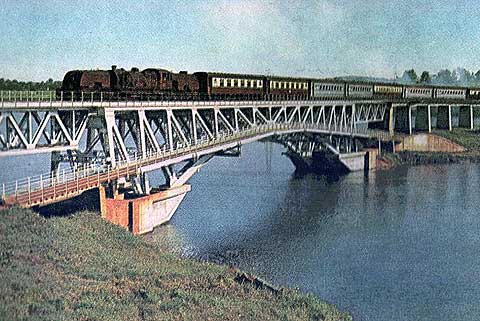
The Uganda Mail crossing the Nile River
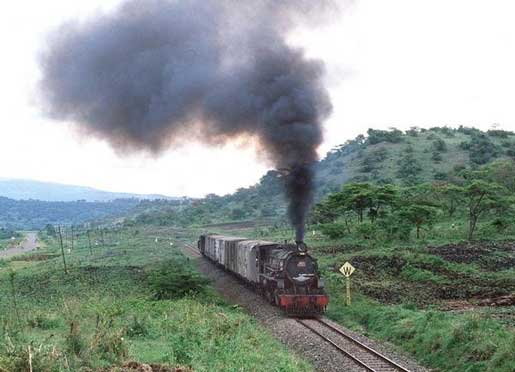
Between Nakuru & Kisumu a train trundeles along.
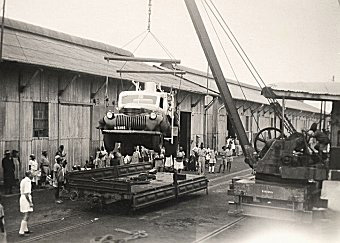
Loading a truck at Mwanza railway station (Tanganyika Railways)

A 29 class train with Mount Longonot in the background.
The Uganda Railways
An appeal for construction-workers was made to India in 1896 its response ‘was not enthusiastic because of unfortunate experiences with indentured labour in other parts of the Empire’, as stated in an official report by Sir John Kirk, one of the founders of the Imperial British East Africa Company, and Vice-Chairman of the Railway Committee in the 1890’s. Subsequently, ‘the government of India agreed to provide labour only on condition that every emigrant, at the end of three years service, would be afforded the threefold option of renewing his contract, returning to his home village with all expenses paid, or remaining in East Africa as a settler and forfeiting his return passage.’
Predominantly Punjabi Muslims, but also many Sikhs and Hindus were recruited for the actual construction. They came mainly through Karachi, and some through Bombay. A few Sindhis as well came via Karachi. As a point of interest, during the same period workers were leaving ports in western India such a Broach, Surat and Kolaba for South and Central Africa.
Very few brought their families to East Africa, but some brought along their servants. A few single men, usually seniors (‘headmen’) took wives from the Swahili camp followers. They could afford this luxury somewhat better than the labourers, who were paid a minimum wage of only fifteen shillings per month.
The reader may find the following points of interest:
- The laying of the first rail commenced in Mombasa on
August 5, 1896 - On June 5, 1899 the railway reached mile 326, a little
over halfway to Kisumu. It was a swampy area that the
Masai called ‘the place of cold waters’: NAIROBI.
On December 19, 1901 it reached mile 582 (931 km), at the shores of Lake Victoria—Port Florence then, Kisumu now.
1 A total of 34,400 Asians worked on the construction of the Mombasa—Kisumu segment
By one authoritative estimate 51% of the Asian workers returned home at the end of their contracts, 20% returned during their contracts due to disease or injury, 8% died on the job, and the remaining 21% (around 7000 men) did not take their tickets for the return journey home from the employer, presumably most of them deciding to stay back in Kenya.
"The railway could not have been finished with (local) labour under 20 years" Sir John Kirk is recorded as having said in the Report of the Committee on Emigration. Mervyn E Hill, the official historian of the Railway went even further in his forthright comment: "Without the aid of Indian labour, artisans and subordinate staff, the railway would not have been built"!
With the Asians’ help it was built in less than five years. (And yet for over 30 years Asians were not allowed, by law, to travel first class on the railway they had built at such high personal cost, 28 of their colleagues having been devoured by the lions of Tsavo—a total of 2,493 having perished at the rate of 4 dead per mile of track laid).
In 1921, the Uganda stretch of the Railway started at Nakuru, to be linked to Kampala in Uganda. In fact eight years earlier, in 1913, the Busoga Railway, connecting Jinja on the shores of Lake Victoria to Namsagali on Lake Kioga, had already come into existence in Uganda! (Busoga Railway was linked to the Kenya line in 1927, four years before the completion of the Eldoret-Kampala stretch)
In 1924, the Uganda Railway reached Eldoret.
It finally reached Kampala in 1931, delayed somewhat by the need to bridge it over the Nile at Jinja.
(courtesy ‘Real African Phantom by Khalid Malik)
=======================================================
‘The Iron Snake’
by
Ronald Hardy
Publishers
Collins St James Place, London 1965
*
“An iron snake will cross from the lake of salt to the lands of the Great Lake”
Ancient Kikuyu prophecy
*
“The railway is the beginning of all history in Kenya”
Sir Edward Grigg
*
“ The two iron streaks of rail that wind away among the hills and foliage of Mombasa Island do not break their smooth monotony until, after piercing Equatorial forests, stretching across immense prairies, and climbing almost to the level of the European snow-line, they pause upon the edges of the Great Lake”
Winston Churchill ‘My Africa Journey’
*
“The line was 582 miles long. It began on 5 August 1896 on the Mombasa mainland and it reached Port Florence on Lake Victoria on 19 December 1901. The capital cost was £5,502,592. The cost in lives was 2,493 Asians and 5 Whites. 31,983 coolies were imported from India. Of these 6,454 were invalidated back to India and 16,312 were repatriated or dismissed. 6,724 Indians remained in East Africa to become the main progenitors of the present Asian population. 43 stations were built and 22 construction locomotives were worn out. The bridging included the Salisbury Bridge
(joining the island of Mombasa to the mainland) of 21 spans of 60-foot girders, 35 viaducts of the Kikuyu and the Mau Escarpments; and 1,280smaller bridges and culverts.”
*
Cost per mile: £ 9,454
Number of men killed per mile: 4.30 men (Asians and Whites)
Number of men imported per mile: 55 men
Number of men invalidated per mile: 11 men
Number of Indians per mile settled in East Africa: 11.5 men
(Sent by Rohina Grewal)
===============================================
Leave a Reply
You must be logged in to post a comment.